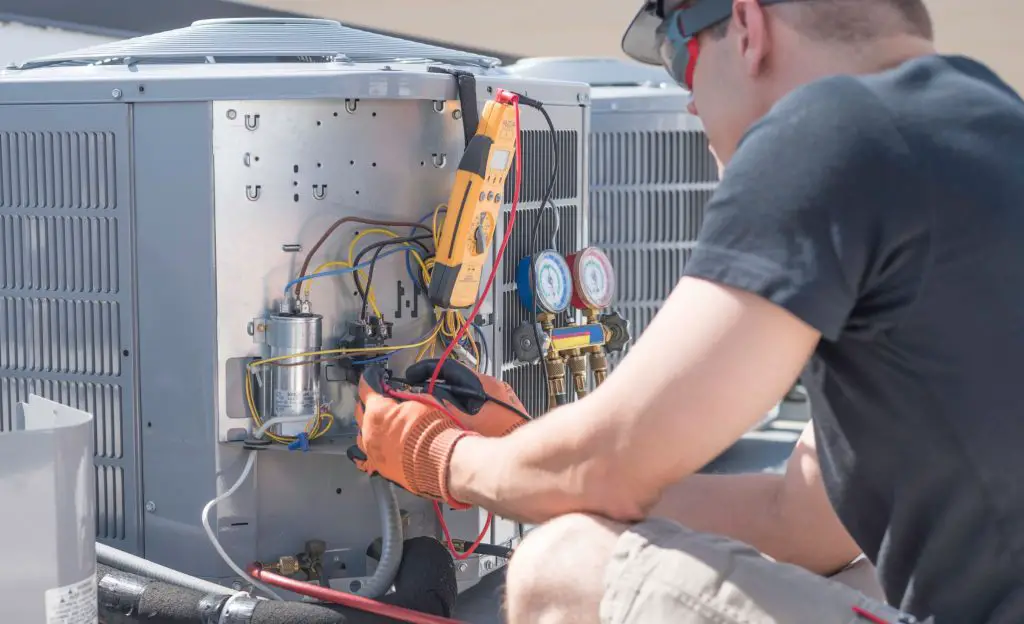Welcome to our detailed guide on HVAC capacitors. These small but mighty components are crucial for your HVAC system. Let’s dive in and learn all about them.
What is an HVAC Capacitor?
An HVAC capacitor is a small device that stores and releases electrical energy. It helps your HVAC system start and run smoothly.
Functions Of An Hvac Capacitor
The HVAC capacitor has two main functions:
- Starting the motor
- Keeping the motor running
Without a capacitor, your HVAC system cannot work efficiently.

Credit: homeguide.com
Types of HVAC Capacitors
There are different types of capacitors. Each type has a specific role in the HVAC system.
Run Capacitor
The run capacitor stays in the circuit all the time. It provides a steady supply of power to keep the motor running.
Start Capacitor
The start capacitor helps the motor start up. It provides a burst of energy and then disconnects from the circuit.
Dual Run Capacitor
This type of capacitor serves two motors. It combines the functions of a run capacitor and a start capacitor.
| Type | Function | Usage |
|---|---|---|
| Run Capacitor | Keeps motor running | In circuit all the time |
| Start Capacitor | Helps motor start | Disconnects after start |
| Dual Run Capacitor | Serves two motors | Combines run and start functions |
Signs of a Bad HVAC Capacitor
It’s important to know when your HVAC capacitor is failing. Here are some signs:
- The HVAC system won’t start
- The system makes a clicking sound
- The system runs but doesn’t blow cold air
- The system turns off by itself
If you notice any of these signs, you may need to replace the capacitor.
How to Test an HVAC Capacitor
Testing an HVAC capacitor is simple. You just need a multimeter. Here are the steps:
- Turn off the power to the HVAC system.
- Locate the capacitor.
- Discharge the capacitor by shorting its terminals with an insulated screwdriver.
- Set your multimeter to capacitance mode.
- Connect the multimeter probes to the capacitor terminals.
- Check the reading against the capacitor’s rating.
If the reading is far from the rating, you need to replace the capacitor.
How to Replace an HVAC Capacitor
Replacing an HVAC capacitor is not very hard. Here are the steps:
- Turn off the power to the HVAC system.
- Locate the capacitor.
- Discharge the capacitor by shorting its terminals with an insulated screwdriver.
- Note the wiring connections or take a picture.
- Remove the old capacitor.
- Install the new capacitor.
- Reconnect the wires as noted or in the picture.
- Turn on the power to the HVAC system.
Always follow safety precautions when working with electrical components.
Maintaining Your HVAC Capacitor
Regular maintenance can extend the life of your HVAC capacitor. Here are some tips:
- Check the capacitor visually for signs of damage.
- Test the capacitor periodically with a multimeter.
- Keep the HVAC system clean to reduce strain on the capacitor.
Proper maintenance can prevent unexpected failures and costly repairs.

Credit: dolphincooling.com
Frequently Asked Questions
What Is An Hvac Capacitor?
An HVAC capacitor stores and releases electrical energy to help start and run your HVAC system efficiently.
How Do Hvac Capacitors Work?
HVAC capacitors provide the initial boost of energy to start the motor and stabilize voltage during operation.
What Are The Types Of Hvac Capacitors?
There are two main types: start capacitors and run capacitors, each serving different functions within the system.
How Long Do Hvac Capacitors Last?
Typically, HVAC capacitors last around 10-20 years, depending on usage and environmental conditions.
Conclusion
The HVAC capacitor is a small but vital part of your HVAC system. Understanding its function, types, and maintenance can help you keep your system running smoothly. Always pay attention to signs of a failing capacitor and replace it if necessary. Regular maintenance will ensure your HVAC system works efficiently for years to come.

